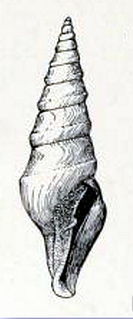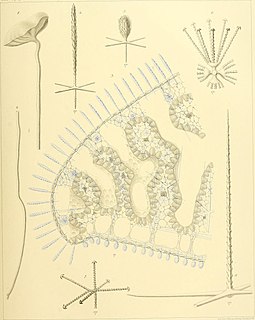
Geodia is a genus of sea sponge belonging to the family Geodiidae. It is the type genus of its taxonomic family.

Franz Eilhard Schulze was a German anatomist and zoologist born in Eldena, near Greifswald.

Borsonella coronadoi is a species of sea snail, a marine gastropod mollusk in the family Borsoniidae.
Felimare agassizii is a species of sea slug or dorid nudibranch, a marine gastropod mollusk in the family Chromodorididae.

Sycon is a genus of calcareous sponges belonging to the family Sycettidae. These sponges are small, growing up to 7.5 cm and having length from 2.5 to7.5, and are tube-shaped and often white to cream in colour. They are known to aquarium hobbyists as "Pineapple" or "Q-Tip" sponges, and are frequent "hitchhikers" accidentally brought in.

Geodia barretti is a massive deep-sea sponge species from the boreal waters of the North Atlantic, fairly common on the coasts of Norway and Sweden. It is a dominant species in boreal sponge grounds, from the North-East Atlantic and the North-West Atlantic. According to morphology and molecular data, this species belongs to the Geodiidae family.

Tetractinellida is an order of sea sponges. First described in 1876, this order received a new description in 2012 and replaced the two orders Astrophorida and Spirophorida, which then became sub-orders as Astrophorina and Spirophorina.

Thorectidae is a family of poriferans in the order Dictyoceratida.

Caulophacus is a genus of glass sponges belonging to the subfamily Lanuginellinae.
Geodia agassizi is a species of sponge in the family Geodiidae. The species is found in the eastern tropical Pacific Ocean and was first described by Robert Lendenfeld in 1910.

Staurocalyptus is a genus of sponge. It was circumscribed in 1897 by Isao Ijima.
Geodia angulata is a species of sponge in the family Geodiidae. It is found in the Pacific Ocean off the coast of California.

Geodia megastrella is a sponge species from the Geodiidae family. It is found in the waters of the North Atlantic. The species was first described by Henry John Carter in 1876.
Geodia atlantica is a sponge species from the Geodiidae family. It is found in the waters of the North Atlantic.
Geodia bicolor is a sponge species from the Geodiidae family. It is found in the waters of the Pacific Ocean off the coast of California.
Geodia breviana is a sponge species from the Geodiidae family. It is found in the waters of the Pacific Ocean off the coast of California. It was first described by Robert J. Lendlmayer von Lendenfeld in 1910.
Geodia amphistrongyla is a species of sponge in the family Geodiidae. The species is found in the tropical Pacific Ocean and was first described by Robert J. Lendlmayer von Lendenfeld in 1910.
Geodia arabica is a species of sponge in the family Geodiidae. It is found in the waters of the Arabian Sea and of the Red Sea. The species was first described by Henry John Carter in 1869.
Geodia carcinophila is a sponge species from the family Geodiidae. The species was first described by Lendenfeld in 1897. It is found in the waters of the Somali Sea around the Zanzibar Archipelago.










